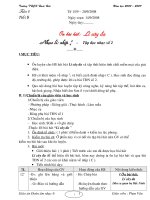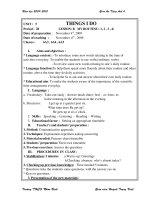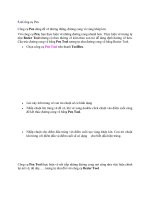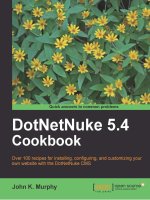5 4 choosing freedom
Bạn đang xem bản rút gọn của tài liệu. Xem và tải ngay bản đầy đủ của tài liệu tại đây (3.03 MB, 10 trang )
CHOOSING
FREEDOM
Fascinating Facts
• When Britain occupied Boston, there was one British
soldier for every four colonists.
• Land was very important to the colonists—nearly 90
percent of them were farmers!
• The British government thought the rebellion would
be easy to end. They did not believe that farmers
would be able to fight.
Genre
Nonfiction
Comprehension Skill
Cause and Effect
Text Features
•
•
•
•
Captions
Time Line
Maps
Sidebar
Scott Foresman Social Studies
ISBN 0-328-14672-2
ì<(sk$m)=beghch< +^-Ä-U-Ä-U
by Ann Rossi
CHOOSING
In the 1700s Britain and the American colonies
did not always agree. Disagreements led to
problems, and problems led to war. In this book
you will read about some of the disagreements
and how they led American Patriots to fight for
their freedom from Great Britain.
FREEDOM
Write to It!
The slogan “Taxation without representation
by popular
Ann Rossi
is tyranny” became
before the
Revolutionary War in America. Write another
slogan that Patriots at that time could have
used to protest British rule. Explain what the
slogan means and why you think it would have
been a good one for the Patriots.
Vocabulary
revenue
tyranny
repeal
tariff
boycott
Write your ideas on a separate sheet of paper.
Patriot
massacre
intolerable
militia
Maps
Mapquest, Inc.
minutemen
Photographs
Every effort has been made to secure permission and provide appropriate credit for photographic material.
The publisher deeply regrets any omission and pledges to correct errors called to its attention in subsequent editions.
Unless otherwise acknowledged, all photographs are the property of Scott Foresman, a division of Pearson Education.
Photo locators denoted as follows: Top (T), Center (C), Bottom (B), Left (L), Right (R), Background (Bkgd).
ISBN: 0-328-14672-2
Copyright © Pearson Education, Inc.
All Rights Reserved. Printed in the United States of America. This publication is protected
by Copyright, and permission should be obtained from the publisher prior to any prohibited
reproduction, storage in a retrieval system, or transmission in any form by any means,
electronic, mechanical, photocopying, recording, or likewise. For information regarding
permission(s), write to: Permissions Department, Scott Foresman, 1900 East Lake Avenue,
Glenview, Illinois 60025.
1 2 3 4 5 6 7 8 9 10 V0G1 14 13 12 11 10 09 08 07 06 05
Opener: The Granger Collection, New York
2 ©Bettmann/Corbis
4 North Wind Picture Archives
5 North Wind Picture Archives;
6 ©Private Collection/Bridgeman Art Library
9 ©Bettmann/Corbis
Editorial Offices: Glenview, Illinois • Parsippany, New Jersey • New York, New York
10 ©Susan Van Etten/PhotoEdit
11(C) ©Massachusetts Historical
Society, Boston,
MA, USA/Bridgeman
Art Library,
(T)TheGeorgia
Granger Collection,
NewIllinois
York
Sales Offices:
Needham,
Massachusetts
• Duluth,
• Glenview,
12 ©New-York Historical Coppell,
Society, New
York,•USA/Bridgeman
Library • Mesa, Arizona
Texas
Sacramento,ArtCalifornia
13 ©Geoffrey Clements/Corbis
15 ©Revere, Paul. Letter to Jeremy Belknap, [1798]. Manuscript Collection/ Massachusetts Historical Society
GREAT
BRITAIN
NORTH
AMERICA
EUROPE
Boston
The
Thir teen Colonies
ATLANTIC OCEAN
With the war over, Great Britain could pay more attention to its
colonies in North America.
This is a map of the Thirteen Colonies.
Great Britain and the Colonies
in 1763
When the French and Indian War ended in 1763,
Great Britain had won most of France’s North
American territories. King George III of Great Britain
now had the time to govern the colonies more closely.
However, new ideas would make it difficult for him to
control his colonies.
People were beginning to talk and write about the
rights of the individual. Among the freedoms and
rights talked about were the right to own property and
the right to participate in government.
In the Thirteen Colonies, people enjoyed many
rights and freedoms. When Great Britain’s Parliament
and king began passing new laws, many colonists felt
that their rights and freedoms were being threatened.
2
3
Taxing the Colonies
After the war with France Great Britain owed a lot
of money. Many British leaders felt that the American
colonies should help pay these debts. In 1764 the
British government began passing laws that they
hoped would increase revenues, or money coming
in, from the American colonies.
The first law was the Revenue Act of 1764, also
called the Sugar Act. It set taxes on sugar from French
and Dutch traders. The taxes angered many colonists.
They wanted sugar that cost less.
The following year, the British passed the Stamp
Act. This required colonists to pay a tax on business
and legal papers. The colonists were angry, and many
refused to pay.
4
Tax stamps such as the ones on these pages showed that a tax
had been paid.
Representatives from several colonies met in
New York to speak out against the Stamp Act. They
believed that only their elected representatives
could tax them, but they had no representatives in
Parliament. So Parliament should not tax the colonies.
They said that ignoring their rights was tyranny, or
the cruel or unfair use of power.
When colonists stopped buying British goods, it hurt
British businesses. The Stamp Act was repealed, or
canceled, in 1766 but another law was passed that
said that Parliament could make laws for the colonies.
5
British soldiers arrive at Long Wharf, Boston Harbor in 1768.
Parliament also passed the Quartering Act in 1765.
This law required colonists to provide food, drink,
housing, coal or firewood, and candles to troops in
their towns.
Colonists often provided fewer supplies than the
soldiers needed. The New York Assembly refused to
assist with quartering British troops.
In 1767 Britain passed laws called the Townshend
Acts. One of these laws said that the New York
Assembly could not do business until it obeyed the
Quartering Act. Another law created tariffs, or taxes,
on many imported goods. In 1768 soldiers were sent
to Boston to make people obey the Townshend Acts.
Angry colonists organized boycotts of British
goods. On March 5, 1770, the British Parliament
agreed to repeal some of the taxes. However, it did
not repeal the tax on tea.
6
7
Violence in Boston
The people of Boston were not happy that Great
Britain had sent more soldiers to their town. Fistfights
became common between soldiers and colonists.
On March 5, 1770, an unfriendly crowd
surrounded a group of British soldiers. Some people
who were there said that people began yelling at
the soldiers and throwing things at them. The soldiers
fired into the crowd. Three people were killed and two
more died later.
Patriots called the incident a massacre, or the
needless killing of a large number of people. The
Patriots called the incident the Boston Massacre. They
used stories of the event to stir up anti-British feelings
among the colonists.
Samuel Adams, a Patriot leader, thought that using
soldiers to make people obey the Townshend Acts was
wrong. He said that the Boston Massacre was a battle
for American liberty.
The British soldiers were put on trial. John Adams, a
cousin of Samuel Adams, defended them. Adams said
that the crowd had started the fight with the soldiers,
so the soldiers were innocent of murder. Two of the
soldiers were found guilty of manslaughter, which
meant they had not planned on killing anyone.
This engraving of the Boston Massacre is by Paul Revere. It helped
build bad feelings against the British.
8
9
After the Boston Massacre
The British troops left Boston shortly after the Boston
Massacre. In 1772 Samuel Adams and other Boston
leaders formed a Committee of Correspondence.
Members sent correspondence, or letters, to other
communities. These letters kept people informed of
events and helped unite the colonies.
Samuel Adams also organized people
against the Tea Act, a law that made it
easier for the East India Company to
sell tea to the colonies. The East India
Company did not have to pay high
taxes, so their tea prices were the lowest
available. In spite of the lower price,
the colonists would not buy the tea.
This is the Boston Massacre Monument in
Boston, Massachusetts.
10
This picture shows the Boston Tea Party.
This bottle was filled with
tea by T.M. Harris. The
date on the label is the day
after the Boston Tea Party.
Merchants in most cities canceled tea orders.
However, the governor of Boston said that three ships
waiting in the harbor should unload their tea—and
they should be paid for it.
On the night of December 16, 1773, a group of
about sixty Patriots, disguised as Mohawks, boarded
the ships and dumped the tea into the harbor. Some
colonists collected samples of tea as souvenirs.
11
Samuel Adams
The Colonies Move Toward War
In February 1775 Britain announced that
Massachusetts was in open rebellion. Two months later
General Gage received secret orders to arrest leaders
of the rebellion, including Samuel Adams. The Patriot
leaders escaped to Lexington.
On April 18, 1775, Patriots in Boston learned that
British soldiers were planning a nighttime march to
Lexington, to search for the Patriot leaders, and then
to Concord, to destroy Patriot supplies. They knew that
the militia must be warned!
At 11 P.M., Paul Revere rode from Boston to warn
militias and leaders that the British were coming.
William Dawes and Samuel Prescott also helped warn
the colonists.
Parliament passed several laws in 1774 to punish
the Patriots for the Boston Tea Party. Colonists called
these laws the Intolerable Acts, because they were
intolerable, or unbearable. The port of Boston was
closed, some town meetings were banned, and British
soldiers returned.
In September 1774 representatives from every
colony except Georgia gathered in Philadelphia for
the First Continental Congress. They voted to stop
trade with Britain until the Intolerable Acts were
repealed. They also agreed to make each colony’s
militia stronger.
Paul Revere rode to Lexington to warn
Patriots that the British were coming.
12
13
The three riders reached Lexington, but Revere
and Dawes were stopped as they left. Only Prescott
reached Concord. Minutemen were ready when the
British arrived in Lexington.
The next day fighting began between British soldiers
and American Patriots in Lexington, Massachusetts.
No one knows who fired the first shot, but it marked
the beginning of the Revolutionary War in North
America.
The Shot Heard Round
the World
In 1836 Ralph Waldo Emerson, an
American writer, wrote about these
events. He called the first shot fired
at Lexington “the shot heard round
the world.” The Patriots’ success
in gaining independence inspired
people in many other lands to
fight for the independence of
their own countries.
This is a letter written by Paul Revere, in which he
describes the events of April 18–19, 1775.
Key Events on the Road to Revolution
1770
1766
1764
Parliament passes
the Revenue Act of
1764, also called
the Sugar Act.
1763
The French and
Indian War ends.
1761
1763
1765
Parliament
abolishes the
Stamp Act, but
passes the
Declaratory Act.
1767
March 5:
Parliament
repeals the
Townshend Acts,
except for the
tax on tea.
The Boston
Massacre occurs.
1769
1773
Parliament passes
the Tea Act.
December 16:
The Boston Tea
Party occurs.
1771
1775
April 19: The
Revolutionary War
in America begins.
1775
1773
1765
1767
1774
The Quartering Act of 1765 and the
Stamp Act are enacted by Parliament.
Parliament passes
the Townshend Acts.
Parliament passes the Intolerable Acts.
September 5–October 26: The first Continental
Congress meets in Philadelphia.
14
15
In the 1700s Britain and the American colonies
did not always agree. Disagreements led to
problems, and problems led to war. In this book
you will read about some of the disagreements
Glossary
and how they led American Patriots to fight for
their
freedom
from Great
Britain.
boycott
organized
refusal
to buy goods
Write to It!
The slogan “Taxation without representation
is tyranny” became popular before the
Revolutionary War in America. Write another
slogan that Patriots at that time could have
used to protest British rule. Explain what the
slogan means and why you think it would have
been a good one for the Patriots.
intolerable unbearable; too much to
be endured
Vocabulary
massacre the cruel and needless killing of
revenue
many people
tyranny
militia a volunteer army
repeal
minutemen colonial militia groups that could
be ready to fight attariff
a minute’s notice
Patriot a colonist boycott
who opposed British rule
of the American Colonies
Patriot
Write your ideas on a separate sheet of paper.
repeal to cancel massacre
revenue moneyintolerable
coming in; income
militiagoods
tariff a tax on imported
Maps
Mapquest, Inc.
tyranny cruel orminutemen
unfair use of power
Photographs
Every effort has been made to secure permission and provide appropriate credit for photographic material.
The publisher deeply regrets any omission and pledges to correct errors called to its attention in subsequent editions.
Unless otherwise acknowledged, all photographs are the property of Scott Foresman, a division of Pearson Education.
Photo locators denoted as follows: Top (T), Center (C), Bottom (B), Left (L), Right (R), Background (Bkgd).
ISBN: 0-328-14672-2
Copyright © Pearson Education, Inc.
All Rights Reserved. Printed in the United States of America. This publication is protected
by Copyright, and permission should be obtained from the publisher prior to any prohibited
reproduction, storage in a retrieval system, or transmission in any form by any means,
electronic, mechanical, photocopying, recording, or likewise. For information regarding
permission(s), write to: Permissions Department, Scott Foresman, 1900 East Lake Avenue,
Glenview, Illinois 60025.
1 2 3 4 5 6 7 8 9 10 V0G1 14 13 12 11 10 09 08 07 06 05
16
Opener: The Granger Collection, New York
2 ©Bettmann/Corbis
4 North Wind Picture Archives
5 North Wind Picture Archives;
6 ©Private Collection/Bridgeman Art Library
9 ©Bettmann/Corbis
10 ©Susan Van Etten/PhotoEdit
11(C) ©Massachusetts Historical Society, Boston, MA, USA/Bridgeman Art Library, (T)The Granger Collection, New York
12 ©New-York Historical Society, New York, USA/Bridgeman Art Library
13 ©Geoffrey Clements/Corbis
15 ©Revere, Paul. Letter to Jeremy Belknap, [1798]. Manuscript Collection/ Massachusetts Historical Society









